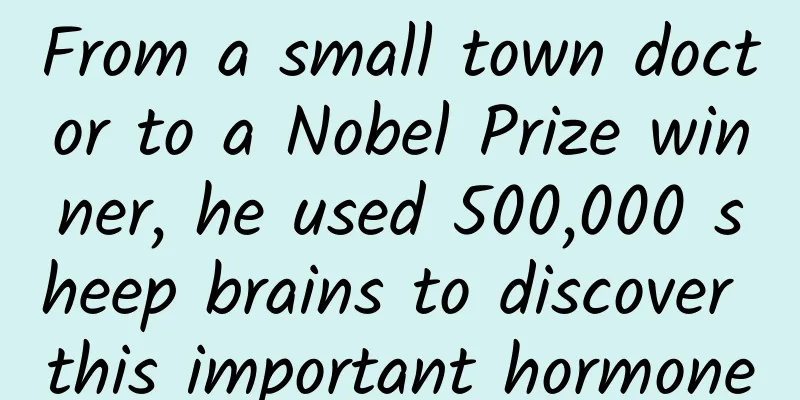From a small town doctor to a Nobel Prize winner, he used 500,000 sheep brains to discover this important hormone

|
The fact that the hypothalamus synthesizes and releases hormones to act on the pituitary gland has long been a basic content in high school biology textbooks. But before scientists actually extracted and synthesized peptide hormones from the hypothalamus, the neuroendocrine hypothesis that the hypothalamus controls pituitary function has always been a heretical theory. The people who changed this view eventually won the Nobel Prize, namely the French-American neurophysiologist Roger Guillemin and his powerful rival Andrew Schally. In February 2024, Guillemin, who had just turned 100, passed away. From a small town doctor to a Nobel Prize winner, his scientific career was legendary. Written by Guo Xiaoqiang (Hebei Institute of Physical Education) French-American neurophysiologist Roger Guillemin discovered several hypothalamic hormones, thus proving the neuroendocrine hypothesis that the hypothalamus controls pituitary function, for which he won the Nobel Prize. He also discovered endorphins involved in pain perception and fibroblast growth factor used to treat eye diseases and diabetic blindness. What's more worth mentioning is that his scientific research life is full of legends. Roger Guillemin (January 11, 1924 - February 21, 2024) 01 Early life On January 11, 1924, Guillemin was born in a wealthy middle-class family in Dijon, the capital of Burgundy, France. His father was a machine tool manufacturer with a relatively stable income. Although his parents were not well educated, they attached great importance to their children's education. Guillemin was very interested in science when he was a child. He liked to collect plant specimens and could distinguish hundreds of plants, observe and dissect frogs with a microscope, and make simple equipment such as radios. Guillemin completed primary education in a local public school in Dijon, and then graduated from the University of Burgundy in 1942 with two degrees in general education and science. After graduation, Guillemin faced an important choice. On the one hand, he was interested in medicine and was ready to enter medical school; on the other hand, he liked to do things by himself and wanted to go to engineering school. He finally chose Dijon Medical College because medicine also requires strong hands-on ability. Unfortunately, Guillemin's idea was not fully realized. At that time, the experimental facilities of the medical school were relatively simple. Except for gross anatomy (only observing the external structure of the human body), there were basically not many instruments, so he could not display his talents in this area. Fortunately, Guillemin met two clinical medicine teachers who taught endocrinology, and the relevant knowledge he learned laid a preliminary foundation for his future scientific research. In 1940, Germany invaded France and Dijon was also occupied. Guillemin's studies were temporarily interrupted, and he subsequently joined an underground organization against Germany. While in school, Guillemin chose to learn German at the suggestion of his mother, which played an important role during World War II. Guillemin relied on his fluent German with a local accent to "get through" the German army's interrogation and search many times and finally escape danger. He helped French refugees and Allied pilots pass the blockade and reach Switzerland safely. For these outstanding contributions, Guillemin was awarded the French Medal in 1973. 02 Help from a noble person In 1947, after graduating from medical school, Guillemin worked as a general practitioner in a small town in the north of Dijon. He devoted himself to providing medical services to the residents and won universal praise from everyone (the two most respected people in the area were doctors and priests). Guillemin felt happy but also depressed at work: first, the effective treatment methods at that time were extremely limited, and most diseases were powerless. The helplessness of patients strengthened Guillemin's motivation to change the status quo; second, Guillemin had always wanted to do scientific research in his heart because he liked to explore the unknown world. According to the French academic system at the time, in order to obtain a doctorate in medicine, one had to complete a research paper and pass the defense. However, post-war France was in ruins, which made the already weak research system even worse. Therefore, Guillemin had the idea of going abroad. By chance, Guillemin learned that Hans Selye, a famous Hungarian-Canadian endocrinologist, would come to Paris to give an academic lecture. He had already known Selye's name from textbooks, and now he had the honor of meeting him in person, which was a once-in-a-lifetime opportunity. Guillemin came to Paris alone with the help of his brother. Seyer arranged three lectures in Paris, mainly introducing new progress in the impact of stress (such as life stress and stress caused by illness) on the body's physiological functions and health. These contents shocked Guillemin greatly. The exquisite slides, passionate speeches and profound knowledge reserves all left a deep impression on Guillemin. Seyer specifically mentioned that stress can stimulate the body to secrete adrenal cortex hormones. Although Guillemin knew only a little about this, he thought it was a very fascinating story, and it was these contents that laid the groundwork for his future research. After Seyer finished his second lecture, Guillemin was eager to come forward to communicate, introducing himself as a young doctor and talking about the idea of going to his laboratory to do some research to obtain a doctor of medicine. Seyer, who completed his education in Europe, had a deep understanding of Guillemin's situation and finally agreed to Guillemin's request. In 1948, Guillemin came to the newly established Institute of Experimental Medicine and Surgery at the University of Montreal where Seyer worked. Over the next year, Guillemin removed both kidneys of rats to create a model of hypertension, and then used peritoneal dialysis to keep the rats alive for several weeks while observing the effects of adrenocortical hormones on the heart. In 1949, Guillemin received a doctorate in medicine from the University of Lyon for these studies. At the same time, Guillemin was truly fascinated by scientific research and gave up the idea of continuing to practice medicine and decided to pursue a doctorate in science. Unsatisfied with the academic atmosphere in France at the time and with the smooth sailing of his work in Canada, he decided to stay in the laboratory and continue his research, and Seyer once again agreed to this idea. In the next four years, Guillemin completed an endocrinology project jointly conducted by McGill University and the University of Montreal, and finally received a doctorate in physiology in 1953. 03Mysterious Hypothalamus The word hormone comes from Greek, which means "excitement", and excitability is one of the basic characteristics of life. There are many hormones in the body, which are involved in many of the most basic life processes, such as regulating metabolism, affecting growth and development, and controlling the reproductive process. Hormones are usually synthesized and released by specific endocrine glands, such as insulin secreted by the pancreas. The more familiar endocrine glands are the thyroid gland, adrenal glands and gonads. There is also an endocrine gland in the brain, called the pituitary gland. As early as the time of Galen, people had discovered that the pituitary gland had a secretory function, but mistakenly believed that it was a channel for the brain to excrete mucus; in fact, the word pituitary in ancient Greek (ἀδήν) originally meant phlegm. With extensive research, people have found that the pituitary gland has an extraordinary role and can be regarded as the "general commander of endocrine glands" because it controls the growth, development and function of multiple endocrine glands such as the thyroid gland, adrenal glands and gonads. The question now is, who controls the pituitary gland? At the end of the 19th century, researchers discovered that nerve fibers can extend from the hypothalamus (part of the brain) to the posterior pituitary gland, affecting the secretion of vasopressin and oxytocin, but no nerves reach the anterior pituitary gland, which is more important. Argentine physiologist Bernardo Houssay found that removing the anterior pituitary gland can cause hypoglycemia in animals, while injecting these animals with anterior pituitary extracts can increase blood sugar, indicating that the anterior pituitary gland has a role in regulating sugar metabolism. Houssay shared half of the 1947 Nobel Prize in Physiology or Medicine. Geoffrey Harris (1913–1971) When Guillemin was at the institute, in order to conduct academic exchanges and expand students' knowledge, the institute invited world-class physiologists to give academic lectures every month, including British physiologist Geoffrey Harris. Harris was very interested in pituitary regulation and conducted a series of experiments in the laboratory. He found that activating hypothalamic activity or destroying hypothalamic structure can affect the secretion of pituitary hormones, suggesting that the hypothalamus controls the pituitary; in addition, although there are no nerve fibers from the hypothalamus to the anterior pituitary, the two are connected by blood vessels, and blood flows from the hypothalamus to the pituitary. Cutting off these blood vessels can destroy the control of the hypothalamus over the pituitary. Harris proposed the hypothesis that the hypothalamus affects pituitary activity by secreting hormones. However, this hypothesis has not been generally recognized by the academic community. At that time, the idea of giving the brain, as a thinking organ, the function of hormone production was too radical (it was considered a bit like "Guan Gong fighting Qin Qiong", that is, two unrelated organs were inexplicably integrated together). The biggest flaw of such a heretical theory is the lack of direct evidence to prove that the hypothalamus has the function of hormone secretion. Hypothalamus and pituitary gland After listening to Harris's report and learning relevant knowledge, Guillemin readily accepted Harris's hypothesis, and at the same time keenly realized that finding the hormone secreted by the hypothalamus was the key to solving the problem. Since Sheyer was more inclined to physiological research and was better at describing physiological phenomena and less concerned with mechanism exploration, Guillemin decided to leave Canada after graduating with a doctorate to start independent research. 04Looking for direct evidence Guillemin first contacted a professor in the Department of Physiology at Yale University who was engaged in hypothalamic research and was offered a teaching position. When he was about to leave, he met another noble person, Hebbel Hoff. Hoff had just been appointed as the director of the Department of Physiology at Baylor College of Medicine. He was very impressed by Guillemin. Although he had learned that Guillemin had obtained a job at Yale University, he still invited him to visit the beautiful Houston and booked a plane ticket for him in an attempt to change Guillemin's mind. The trip to Houston left a deep impression on Guillemin. The wide experimental space, sufficient scientific research funds, free academic atmosphere and livable living environment made him finally change his decision. Soon after, he became a young assistant professor in the Department of Physiology at Baylor College of Medicine and started independent research - exploring the mechanism of hypothalamic regulatory function. Soon after Guillemin arrived in Houston, he visited the laboratory of Charles Pomerat. Pomerat was culturing anterior pituitary cells, which were morphologically normal but did not secrete any hormones. Guillemin realized that this might be due to the lack of hypothalamic stimulation, so he suggested co-culturing with the hypothalamus. Pomerat eventually detected adrenocorticotropic hormone (ACTH) in the culture medium, a hormone secreted by the anterior pituitary. This result provided important evidence for Harris' hypothesis; more importantly, they established an in vitro system for detecting hypothalamic secretory activity, which greatly simplified the operation. In the summer of 1955, Guillemin went to Harris Laboratory in London for academic exchanges and presented his results of in vitro experiments to prove the secretory function of the hypothalamus. This exchange broadened Guillemin's horizons, provided him with more ideal scientific research ideas for further experimental design, and made him firmly believe in the correctness of Harris's hypothesis. As a result, no matter how great the difficulties he encountered later, he persisted without hesitation and did not question his original choice and give up. Guillemin decided to recruit more people to speed up the research. At a seminar on hypothalamic function held by the medical school, he successfully attracted the young biochemist Walter Hearn to join. After discussion, they agreed that the most direct way to prove the secretory function of the hypothalamus was to isolate hormones, but they lacked experience in this area. Fortunately, the opportunity arose again and they got help from Vincent du Vigneaud. Vincent du Vigneaud (1901-1978) Di Vigneault was a famous biochemist who won the 1955 Nobel Prize in Chemistry for the identification of the structures of the posterior pituitary hormones vasopressin and oxytocin. He was invited to give lectures in various places, including Houston, and Guillemin got to know Di Vigneault and invited him to his home. Guillemin introduced his ideas on hypothalamic research to Di Vigneault and asked him what separation system was best, because many separation methods such as paper chromatography and column chromatography appeared at that time. Di Vigneault gave advice based on his own research experience: First of all, it is not about choosing an advanced separation method, but about obtaining enough experimental materials from animals; this is a hurdle that cannot be circumvented, for example, the study of vasopressin and oxytocin first requires obtaining the pituitary of cattle. Following this suggestion, Guillemin decided to solve the problem of material collection first. Since the nature of hypothalamic activation was still unclear, in order to prove the in vivo results, a large number of hypothalamus needed to be collected. Initially, he chose cattle as donors, but unfortunately it was too difficult to obtain the materials and he gave up. After many comparisons, he finally found that sheep hypothalamus was easy to operate and suitable as materials. Just as he was preparing to make a big move, a new problem arose: Hearn joined Iowa State University, and his departure brought great difficulties to further research. Guillemin had to publish a recruitment information to look forward to new people joining. Soon, Guillemin received a job application letter from Andrew Schally, and this turned around. 05Cooperation and competition Andrew Schally (1926-) Born in Wilno, Poland (now Vilnius, Lithuania) into a military family, Shali came to the UK to study after World War II. Because of his love for medicine, he joined the National Institute for Medical Research after graduation, where he met many famous scientists (some of whom later won the Nobel Prize). This experience enabled him to master many emerging technologies and, like Guillemin, deepened his interest in academic research. In May 1952, Sally came to McGill University in Montreal, Canada, and followed Murray Saffran to study adrenocorticotropin, thus entering the field of endocrinology. At that time, it was known that stress could increase the secretion of adrenocorticotropin by the pituitary gland. In 1955, Sally and Saffran collaborated to discover that the hypothalamus could produce corticotropin releasing factor (CRF), which regulates pituitary function. In May 1957, Sally obtained his doctorate and was originally prepared to continue his research on CRF in the laboratory, but because of Saffran's academic leave, he had to find another way. Only then did he send a job application letter after learning that Guillemin was also engaged in related research. At first, the two communicated very smoothly, and their common goals made them quickly reach a cooperation agreement. In September 1957, Sally officially joined Guillemin's laboratory and started the CRF separation and identification project. Guillemin was responsible for collecting sheep hypothalamus, and Sally was responsible for CRF purification. In order to speed up the experimental process, Guillemin also arranged for Sally to go to Stockholm, the capital of Sweden, to learn the separation technology - the use of chromatography, and to Uppsala to obtain new chromatography column fillers. In 1960, Guillemin accepted a job at the Collège de France in Paris, and Hof tried his best to keep him. They finally reached an agreement that Guillemin would retain the laboratory at Baylor College of Medicine, which would be managed by Salie and guaranteed sufficient funding. After Guillemin returned to France, he found that the Paris slaughterhouse could provide a large number of sheep hypothalamus, which could solve the material problem well. Guillemin shuttled between Paris and Houston, and the two laboratories progressed in parallel, but the result was counterproductive. The physiological experiments went relatively smoothly and provided more evidence for the secretory function of the hypothalamus, but there was no breakthrough in the separation of CRF, as if CRF was within reach, but out of reach. The failure of the experiment caused internal and external difficulties. Many scientists questioned their research direction, believing that the hypothalamus could not have secretory functions and that these studies were meaningless. The bigger problem was that there was a huge disagreement between Guillemin and Shali, who blamed each other. There were subjective and objective factors that led to this result. Subjectively, the two had a deviation in their understanding of the research project. In Guillemin's view, he was the head of the laboratory and Shali was an assistant; but in Shali's view, he had his own ideas at the beginning, and what he lacked was a research platform. Guillemin had a huge advantage in this regard, so they should be equal cooperation rather than an employment relationship. However, he was always at a disadvantage at work and had a certain inferiority complex. This also caused Shali to prefer to show off in subsequent competitions in order to surpass Guillemin in action. In fact, their goals were indeed difficult to achieve, of course, this is a later story-CRF was not finally purified until more than 20 years later. In June 1962, the Veterans Administration Hospital in New Orleans was preparing to set up a laboratory dedicated to the study of the hypothalamus and invited Salley to be the director. Salley left Baylor College of Medicine to set up his own research team and recruited talents to become a strong competitor of Guillemin. If cooperation is a kind of hurt, then separation is also a kind of relief. Their cooperative relationship evolved into a competitive relationship, which accelerated the research process because they both tried to prove that the failure of the experiment was due to the other party. 06Forge ahead Guillemin re-examined the problems of the past few years. In fact, despite all the setbacks, Guillemin and Shali firmly believed that the initial choice was not wrong, but there were problems in the specific implementation. First, they underestimated the difficulty of the problem. The content of hormones secreted by the hypothalamus was extremely low, so it was necessary to collect excessive experimental materials; second, it was necessary to increase multidisciplinary cross-integration and strengthen research on protein purification and synthesis (a lot of evidence has shown that the hormones produced by the hypothalamus should be protein-based); finally, a new hormone was selected. Combining the research experience of Guillemin's laboratory and the latest progress in the field, it was decided to replace it with thyrotropin-releasing factor (TRF). This choice was based on the emergence of hormone radioimmunoassay technology in the 1960s, which can directly detect hormone content instead of the previous indirect method of determining hormone content through physiological activity (one of the reasons for the initial selection of CRF). After many considerations, Guillemin returned to Houston from Paris in November 1963 to become the director of the neuroendocrinology laboratory at Baylor College of Medicine, and devoted himself to the study of hypothalamic hormones. With the help of the embassy, Guillemin transported the large number of sheep hypothalamus he collected in Paris back to Baylor College of Medicine. After returning to Houston, Guillemin visited several large slaughterhouses and finally collected 500,000 sheep hypothalamus. Then he processed, processed, freeze-dried and extracted more than 50 tons of fresh frozen tissue in the laboratory, and finally only obtained 1 mg of hormone for further analysis. The difficulty of the work can be imagined. In terms of team building, Guillemin recruited chemist Roger Burgus and physiologist Wylie Vale to join. Coincidentally, Burgus was a student of Hearn, Guillemin's first collaborator, so he was more familiar with Guillemin's research and quickly got involved in the research. At the same time, Shali's team was also carrying out similar research in full swing. Shali chose pigs as experimental animals because he wanted to avoid duplication with Guillemin. This choice was somewhat of a gamble, but it brought unexpected results. Compared with sheep, although pigs are inconvenient to obtain, they have a large slaughter volume and a richer source, and a steady supply of materials has become a reliable guarantee for experiments. In particular, due to Shali's efforts, his team received a significant reward from a slaughterhouse - the other party donated the hypothalamus of one million pigs free of charge (finally 2.8 mg of pure product was obtained). In this way, the money originally used to purchase experimental materials was saved and used to recruit outstanding personnel to join, thus catching up. By the end of 1968, the two teams had been studying TRF for nearly six years, but there was still no clear conclusion. Many scientists in the industry were impatient, so they suggested holding a seminar to determine whether further funding was necessary based on the progress. In January 1969, the seminar was held in Tucson, Arizona. At the meeting, the Sally team first reported that TRF was composed of three amino acids, and then Guillemin also reported the same conclusion, which gave the participants initial confidence. Guillemin's team then synthesized the tripeptide based on the sequence, but unfortunately it had no biological activity. Bergs suggested that it might be due to amino acid modification. After improvements on this basis, they finally artificially synthesized TRF with biological activity. These results were published in the Proceedings of the French Academy of Sciences on November 12 of the same year, because the publication speed of the journal was fast at that time, unlike Science and the Proceedings of the National Academy of Sciences of the United States, which required a long time for review; Guillemin was not yet a member of the American Academy of Sciences, and there was no fast track to publish papers. The paper of the Sally team was published on November 6, 1969, just 6 days ahead of schedule. 07Honor The identification of TRF eliminated people's doubts about the secretory function of the hypothalamus. More researchers joined this field, and the two teams of Guillemin and Shali were in the leading position. Their next goal was luteinizing hormone-releasing hormone (LRF). The excellent foundation laid in the early stage greatly accelerated the subsequent research process. Soon the two teams successively determined that LRF was a polypeptide composed of ten amino acids (Shali was one month ahead). Guillemin then wanted to find the growth hormone-releasing hormone produced by the hypothalamus, but accidentally discovered somatostatin, a fourteen peptide that can strongly inhibit the secretion of pituitary growth hormone. The identification of a series of new hormones directly proved the correctness of Harris's hypothesis and also clarified more functions of the hypothalamus. Guillemin and Schally's reputation in the scientific community quickly increased, and a series of honors and awards followed. In 1974, Guillemin was elected a member of the American Academy of Sciences, and in the same year he shared Canada's Gairdner International Award with Schally; he also won the Lasker Basic Medical Research Award (1975, shared with Schally); the Passano Award in Medical Sciences (1976); and the Dickson Prize in Medicine (1977). In addition, Guillemin also won the 1976 American Medal of Science. In the end, Guillemin and Schally shared 1/2 of the 1977 Nobel Prize in Physiology or Medicine for " discoveries on the production of brain peptide hormones " (the other 1/2 was won by Mrs. Yellow; Editor's Note: See "She invented a method for measuring hormones but gave up the patent. After winning the Nobel Prize, she wanted to become the best in the world"). Guillemin is known as the "Father of Neuroendocrinology" for his outstanding scientific contributions. There is actually a little controversy here, because Harris also has this title. Harris is a theoretical pioneer, and Guillemin is an experimental master, both of whom have made important contributions to the birth of neuroendocrinology. In terms of scientific influence, Guillemin is more recognized (he experimentally confirmed hypotheses and won a series of scientific awards, especially the Nobel Prize), while Harris did not receive more recognition from the scientific community due to his death in 1970 (if he was alive in 1977, he would be an important competitor for the Nobel Prize in Physiology or Medicine). 08Many achievements In June 1970, Guillemin's team left Baylor College of Medicine and joined the newly established Salk Institute's Neuroendocrinology Laboratory. In addition to continuing his research on hypothalamic hormone-releasing hormones, he also expanded his research content. In 1975, researchers discovered the activity of opioids (such as morphine, etc.) in the brain, called endorphins, but the sequence was unknown. Guillemin, who had a strong advantage in protein purification and sequencing, was keenly aware of the importance of this issue, so he started research and finally determined the complete sequence at the end of 1976, but called it enkephalin. In addition, Guillemin's team also made important contributions to the isolation and structural identification of fibroblast growth factor (FGF), inhibin and activin activity, etc. In 1989, Guillemin retired from the Salk Institute and moved to the Whittier Diabetes and Endocrinology Institute to continue his work. In addition to these jobs, Guillemin also served as the management of the Salk Institute and the Endocrine Society to promote the development of the discipline. 09 Happy Life 1951 was an important year for Guillemin. Guillemin and three other members of the Cheyer laboratory were inexplicably infected with tuberculosis almost at the same time. At that time, tuberculosis was still a difficult disease, and one of them died soon after. Guillemin also had tuberculous meningitis while suffering from lung infection, which made the situation even worse. Guillemin, who had medical experience, was deeply aware of the seriousness of the problem. During his internship, he saw that all children with tuberculous meningitis died. Fortunately, streptomycin had been successfully developed and put into clinical use at that time. Guillemin immediately contacted the streptomycin manufacturer and used the drug in time. After three months of full treatment and meticulous care, Guillemin finally recovered. A blessing in disguise, Guillemin fell in love with Lucienne Jeanne Billard, a nurse who took care of him diligently, during his hospitalization. The two got married shortly after being discharged from the hospital and later had 6 children. Lucienne stayed at home to take care of her husband and children, and ensured that Guillemin would devote all his energy to work. The two spent 69 years together. In 2021, Lucienne passed away at the age of over 100; three years later, on February 21, 2024, Guillemin, who had just celebrated his 100th birthday, died at his home in Salk. Guillemin was an art lover who collected many contemporary American and French paintings; he was also a gifted abstract artist whose works had been exhibited in the United States and Europe. These works enriched his spare time and were another passion of his besides scientific research. Lucienne Guillemin (1921-2021) Guillemin's lifelong scientific contributions have had a huge impact on the world, as he elucidated the mechanism of the hypothalamus regulating hormone production, thus opening up new treatments for many diseases, including endocrine disorders and mental health problems, and in particular, providing new ideas for understanding the mechanisms by which stress and other environmental factors affect physical and mental health. Guillemin's career perfectly illustrates the importance of scientific competition. In an era when collaboration is often emphasized as the key to success, his experience shows that competition can better promote scientific development when it is rooted in the common pursuit of knowledge. To be successful, you need friends, and to achieve great success, you need a strong "enemy", the enemy here refers to your competitors, who prevent you from slacking off and remind you to work every minute. Guillemin's influence goes beyond his scientific discoveries. His unyielding spirit of exploration and his unyielding perseverance over the 14 years before and after the discovery of hypothalamic releasing hormone have inspired generations of researchers to overcome difficulties with rigor and determination. Therefore, Guillemin left behind not only achievements but also inspiration, demonstrating the infinite power of curiosity to promote scientific development. Guillemin's life experience perfectly illustrates what he believes to be the three elements of scientific success: being smart enough, working hard enough, and being lucky enough, with luck being particularly essential. Main references [1] Guillemin R. Peptides in the brain: the new endocrinology of the neuron. Science, 1978, 202(4366):390-402. [2] Guillemin R. A conversation with Roger Guillemin. Interview by Greg Lemke. Annu Rev Physiol. 2013, 75:1-22. [3] Wade N. Guillemin and schally: the years in the wilderness. Science,1978, 200(4339):279-782. [4] Burgus R, Dunn TF, Desiderio D, Guillemin R. [Molecular structure of the hypothalamic hypophysiotropic TRF factor of ovine origin: mass spectrometry demonstration of the PCA-His-Pro-NH2 sequence]. CR Acad Hebd Seances Acad Sci D, 1969, 269(19):1870-1873. [5] Burgus R, Dunn TF, Desiderio D, Ward DN, Vale W, Guillemin R. Characterization of ovine hypothalamic hypophysiotropic TSH-releasing factor. Nature, 1970, 226(5243):321-325. [6] Brazeau P, Vale W, Burgus R, Ling N, Butcher M, Rivier J, Guillemin R. Hypothalamic polypeptide that inhibits the secretion of immunoreactive pituitary growth hormone. Science. 1973, 179(4068):77-79. [7] Guillemin R. Endorphins, brain peptides that act like opiates. N Engl J Med. 1977, 296(4):226-228. This article is supported by the Science Popularization China Starry Sky Project Produced by: China Association for Science and Technology Department of Science Popularization Producer: China Science and Technology Press Co., Ltd., Beijing Zhongke Xinghe Culture Media Co., Ltd. Special Tips 1. Go to the "Featured Column" at the bottom of the menu of the "Fanpu" WeChat public account to read a series of popular science articles on different topics. 2. Fanpu provides a function to search articles by month. Follow the official account and reply with the four-digit year + month, such as "1903", to get the article index for March 2019, and so on. Copyright statement: Personal forwarding is welcome. Any form of media or organization is not allowed to reprint or excerpt without authorization. For reprint authorization, please contact the backstage of the "Fanpu" WeChat public account. |
<<: A mysterious area that covers 60% of the Earth hides a new discovery in ecology!
>>: What is sleep paralysis? People who are often "pressed" should be careful!
Recommend
Have you checked out these 9 kinds of autumn leaf trees this fall?
This fall, which popular tourist spots suitable f...
Why do beverage bottles have five-petal flowers on the bottom?
Review expert: Meng Meng, associate researcher at...
World Resources Institute: Accelerating Climate Resilient Infrastructure
The report released by the Intergovernmental Pane...
How to prepare a brand marketing promotion plan?
Writing a branding plan may seem difficult becaus...
In addition to operational knowledge, where can APP operations get inspiration?
On June 21, the article titled "Just now, th...
The vibrant green is actually the color of death?
This painting, in bright green, makes the whole r...
New clues have been added to the "origin of the moon". Where did this mysterious planet come from?
How was the Moon formed? The most mainstream hypo...
Hisense Art TV 75R8K review: A disruptor of mural TVs
As an important device for home entertainment, TV...
Be the best or nothing: Touchscreen CEO Chen Haozhi's ambition
On the morning of October 28, the 9th Cocos Devel...
Cutting-edge practical experts: SEO trend prediction for 2016!
Search engine optimization has become one of the ...
When there is only one Java programmer left in the world
[[236202]] In the year 2050, there is only one Ja...
Black Myth: Wukong is a huge hit, but Zhang Daxian is complaining about it on his livestream. What's going on?
August 20 Based on Chinese mythology Action RPG C...
How many days in advance can we visit the graves during the Qingming Festival in 2022? What are the rules for visiting graves? The best time to visit graves!
The Qingming Festival holiday begins tomorrow. Du...
Not only SU7 and YU7, Xiaomi's third model has also been exposed, this time it is a 150,000-class extended-range SUV
As a "newcomer" in the automotive indus...
Yiche: Ranking of hard-core off-road vehicle sales from January to August 2024 and August: Tank 300 sales volume was 52,466 units
Since the launch of the Tank 300, domestic consum...









